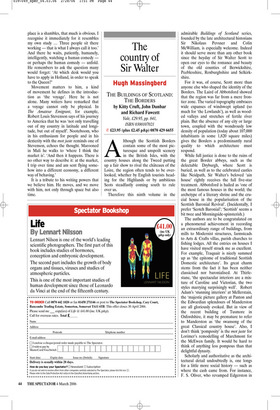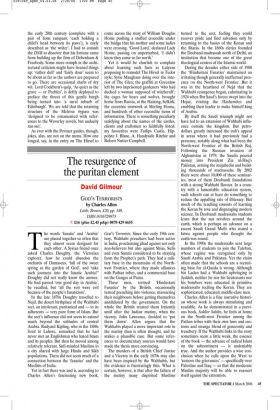The country of Sir Walter
Hugh Massingberd
THE BUILDINGS OF SCOTLAND: THE BORDERS by Kitty Cruft, John Dunbar and Richard Fawcett Yale, £29.95, pp. 841, ISBN 0300107021 ✆ £23.95 (plus £2.45 p&p) 0870 429 6655 Although the Scottish Borders contain some of the most picturesque and unspoilt scenery in the British Isles, with the country houses along the Tweed putting up a fair show to rival the châteaux of the Loire, the region often tends to be overlooked, whether by English tourists heading for the Highlands or by ambitious Scots steadfastly coming south to rule over us.
Therefore this ninth volume in the admirable Buildings of Scotland series, founded by the late architectural historians Sir Nikolaus Pevsner and Colin McWilliam, is especially welcome. Indeed it should serve more than any other book since the heyday of Sir Walter Scott to open our eyes to the romance and beauty of the old counties of Berwickshire, Peeblesshire, Roxburghshire and Selkirkshire.
For it was, of course, Scott more than anyone else who shaped the identity of the Borders. The Laird of Abbotsford showed that the region was far from a mere frontier zone. The varied topography embraces wide expanses of windswept upland (so much for ‘the Lowlands’), as well as wooded valleys and stretches of fertile river plain. But the absence of any city or large town, coupled with the wondrously low density of population (today about 107,000 inhabitants in some 1,820 square miles) gives the Borders a predominantly rural quality to which architecture must respond.
While full justice is done to the ruins of the great Border abbeys, such as the delectable Dryburgh, where Scott is buried, as well as to the celebrated castles like Neidpath, Sir Walter’s beloved ‘ain house’ rightly receives the full five-star treatment. Abbotsford is hailed as ‘one of the most famous houses in the world; the archetype of a literary shrine and the crucial house in the popularisation of the Scottish Baronial Revival’. (Incidentally, I prefer ‘Scotch Baronial’; ‘Scottish’ seems a bit twee and Morningside-spinsterish.) The authors are to be congratulated on a phenomenal achievement in recording an extraordinary range of buildings, from mills to Modernist structures, farmsteads to Arts & Crafts villas, parish churches to fishing lodges. All the entries on houses I have visited myself struck me as excellent. For example, Traquair is nicely summed up as ‘the epitome of traditional Scottish Domestic architecture’. Its great charm stems from the fact it has been neither classicised nor baronialised. At Thirlestane, ‘the spectacular interiors are a mixture of Caroline and Victorian, the two styles marrying surprisingly well’. Robert Adam’s ‘stunning interiors’ at Mellerstain, the ‘majestic picture gallery at Paxton and the Edwardian splendours of Manderston are all gloriously evoked. But in view of the recent building of Tusmore in Oxfordshire, it may be premature to refer to Manderston as ‘the swansong of the great Classical country house’. Also, I don’t think ‘pomposity’ is the mot juste for Lorimer’s remodelling of Marchmont for the McEwen family. It would be hard to think of anything less pompous than that delightful dynasty.
Scholarly and authoritative as the architectural detail undoubtedly is, one longs for a little more social history — such as where the cash came from. For instance, F. S. Oliver, who revamped Edgerston in the early 20th century (complete with a pair of lions rampant, ‘each holding a child’s head between its paws’), is coyly described as ‘the writer’. I had to consult the DNB to discover that his fortune came from building up the firm of Debenham & Freebody. Some more oomph in the architectural criticism might have livened things up: ‘rather dull’ and ‘fairly dour’ seem to be about as far as the authors are prepared to go. There are occasional shafts of dry wit. Lord Cockburn’s quip, ‘As quiet as the grave — or Peebles’, is deftly deployed to preface the threat of this gentle burgh being turned into ‘a rural suburb of Edinburgh’. We are told that the retaining structure of the Melrose bypass was ‘designed to be ornamented with references to the Waverley novels, but audacity ran out’.
As ever with the Pevsner guides, though, jokes, alas, are not on the menu. How one longed, say, in the entry on The Hirsel to come across the story of William Douglas Home pushing a stuffed crocodile under the bridge that his mother and some ladies were crossing. ‘Good Lord,’ declared Lady Home, passing on unperturbed, ‘I didn’t know they came so far north.’ Yet it would be churlish to complain about learning such facts as Lutyens proposing to remodel The Hirsel in Tudor style; Syrie Maugham doing over the interior of The Glen; the graffiti at Greenlaw left by two imprisoned gardeners ‘who had ducked a woman supposed of witchcraft’; the cages for bears and wolves, brought home from Russia, at the Haining, Selkirk; the eccentric ironwork at Skirling House, and hundreds of other recondite items of information. There is something peculiarly satisfying about the names of the castles, clients and craftsmen so faithfully listed: my favourites were Fatlips Castle, Hippolyte J. Blanc, A. Handyside Ritchie and Robert Nutter Campbell.











































































 Previous page
Previous page